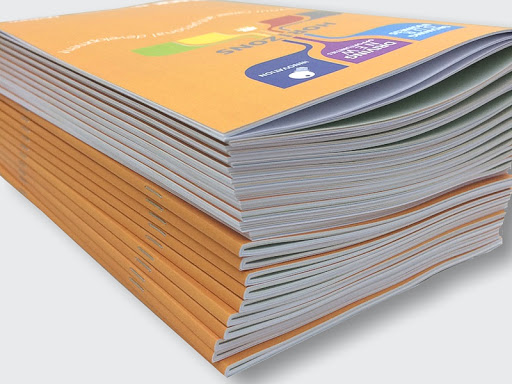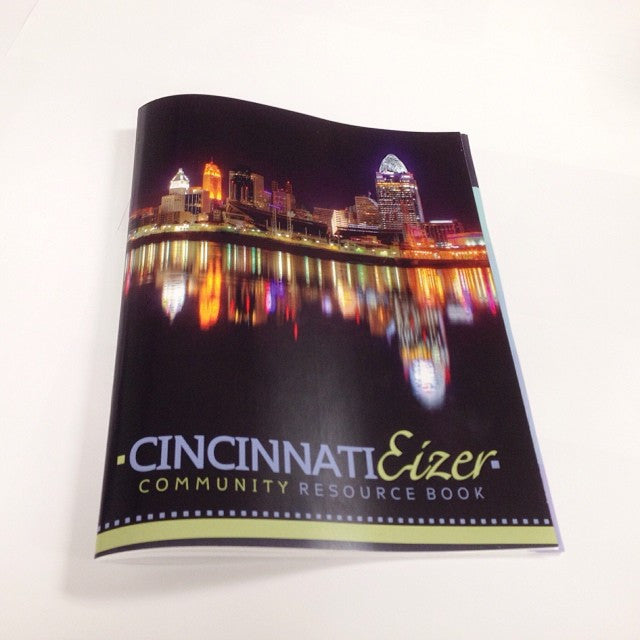Booklet Printing FAQs: Everything You Need to Know Before You Order
Booklet Printing FAQs: Everything You Need to Know Before You Order
Blog Article
The Important Guide to Comprehending Pamphlet Printing Options and Techniques
The process of brochure printing includes multiple considerations that can substantially influence the last item. From selecting the ideal style and dimension to comprehending the subtleties of binding techniques, each choice plays a necessary function. Additionally, variables such as paper supply and printing techniques further affect the efficiency of the brochure. As one browses these choices, it comes to be crucial to realize how they interconnect and what that indicates for the overall outcome.
Comprehending Booklet Sizes and styles
When considering pamphlet printing, recognizing the various layouts and dimensions available is essential for attaining the wanted discussion. Brochures can be generated in various layouts, including saddle-stitched, spiral-bound, and perfect-bound, each offering distinct benefits. Typical dimensions vary from conventional letter (8.5 x 11 inches) to smaller sized choices like A5 (5.8 x 8.3 inches), permitting flexibility based on material and target audience.Selecting the ideal size can influence both the design and reader involvement. Larger sizes may suit aesthetically driven material, while smaller sized layouts may be extra portable and straightforward. Furthermore, the variety of web pages influences the option of binding approach, as thicker pamphlets might require sturdier bindings. Eventually, recognizing these aspects enables a much more customized approach, guaranteeing that the end product straightens with the intended message and visual, improving the overall performance of the communication.
Selecting the Right Paper Stock

Binding Techniques: Factors To Consider and choices
When it pertains to binding approaches for pamphlets, a number of options are readily available, each with distinctive benefits. Saddle stitch binding provides an affordable remedy for thinner booklets, while excellent binding techniques offer a more sleek look for thicker magazines. Wire-O binding stands apart for its sturdiness and convenience of usage, making it excellent for documents that require flexibility.
Saddle Stitch Binding
Saddle stitch binding supplies a cost-effective and practical option for putting together brochures, making it a popular option among businesses and publishers. This binding method involves folding sheets of paper in half and stapling them along the fold line, developing a well organized and neat look. Commonly suitable for pamphlets with a lower page matter, saddle sewing is ideal for publications, pamphlets, and training products. The simpleness of this technique permits fast production and is frequently favored for brief runs or promotional items. Nonetheless, it is important to keep in mind that saddle stitch binding may not be ideal for thicker booklets, as the spine might not stand up under raised weight. Overall, it stays a reliable choice for many printing projects.
Perfect Binding Techniques
Perfect binding is a commonly utilized technique that provides a polished and expert finish to magazines and pamphlets. This technique entails gluing the web pages together at the spine making use of a solid adhesive, enabling a clean edge and the capacity to hold a larger number of pages contrasted to saddle stitching. Perfect binding is specifically appropriate for thicker booklets, such as magazines and yearly reports, where a strong, flat back is wanted. Additionally, it provides the choice for a published cover that can be designed to boost visual appeal. Factors to consider such as web page matter, paper weight, and the intended usage of the booklet should be taken into account, as they can affect toughness and total top quality.
Wire-O Binding Alternatives
Wire-O binding, understood for its durability and adaptability, uses an excellent choice for brochures that need easy web page turning and an expert look. This binding method employs a collection of steel loopholes that hold pages safely, enabling them to lie level when open. It is especially appropriate for manuals, discussions, and catalogs due to its robust nature. Wire-O binding is readily available in different colors and diameters, suiting different page matters and thicknesses. Furthermore, it permits the inclusion of tabs and covers, enhancing the pamphlet's total aesthetic. Factors to consider for Wire-O binding consist of the choice of cable shade, the dimension of the loops, and the extent of personalization desired, all of which can greatly influence the end product's appearance and performance.
Digital vs. Offset Printing: Which Is Best for You?
When selecting a printing method for booklets, comprehending the distinctions in between electronic and counter printing is crucial. Digital printing makes use of modern-day technology to produce high-quality prints promptly and cost effectively, making it excellent for short runs or projects requiring fast turnaround times. It permits modification, supplying the ability to print on-demand with very little waste.In contrast, counter printing is a conventional method that masters generating large quantities with regular quality. It entails transferring ink from a plate to a rubber blanket, then to the paper, which causes accurate information and lively shades. Counter printing typically needs longer arrangement times and is extra cost-effective for larger volumes.Ultimately, the selection in between digital and counter printing depends on job demands, budget, and desired quantity. For little, time-sensitive projects, digital could be the ideal option, while offset might be more effective for larger, top notch manufacturings.

Designing Your Booklet: Tips and Finest Practices
When designing a booklet, cautious focus to layout, font option, and shade usage can significantly boost its performance. A well-structured layout guides the viewers's eye, while ideal fonts assure readability and share the desired tone. Furthermore, efficient use of color can evoke emotions and highlight vital information, making the total design much more impactful.
Choosing the Right Format
Just how can one efficiently select the best design for a pamphlet? First, it is crucial to review the booklet's function and target market. A clean, arranged layout improves readability and involvement. Using a grid system can help in lining up aspects continually, producing a professional appearance. Additionally, integrating aesthetic hierarchy with varying sizes and positionings of images and message can guide the reader's eye and highlight crucial information. It is additionally essential to leave enough white area, which avoids congestion and enables for better focus. Testing different formats with mock-ups can give understanding right into exactly how the design does in real-world circumstances, ensuring that the final product satisfies both useful and aesthetic demands.
Selecting Appropriate Font Styles
An appropriate font can substantially boost the general layout of a booklet, matching the design and reinforcing the material's message. The selection of fonts must think about readability, particularly for body text, as it ensures the information comes to all viewers. Sans-serif typefaces are usually chosen for electronic formats, while serif font styles can lend a traditional feeling in printed products. It's advisable to restrict font choices to two or three to keep visual coherence. Furthermore, typeface dimension plays a crucial duty; headings should be distinct however not overwhelming, while body text need to be comfortable for reading. When picking font styles, placement with the pamphlet's motif and target market is vital for effective communication and aesthetic charm.
Efficient Use of Color
Shade functions as an effective device in pamphlet design, guiding and forming assumptions reader emotions. It can evoke feelings of peace, trust, or enjoyment, depending upon the hues chosen. Developers should consider shade concept principles, ensuring that the picked scheme aligns with the pamphlet's message and target audience. Utilizing warm shades like red and orange can produce seriousness, while cooler tones like blue and eco-friendly foster tranquility.Additionally, contrast plays a crucial role; complementary colors can improve readability and visual charm. Uniformity in shade use throughout pages further enhances brand name identification and cohesion. Eventually, reliable shade application not just records attention yet additionally strengthens the booklet's objective, making it a crucial aspect of effective style.
Ending Up Touches: Coatings and Special Effects
While several consider the web content and design of a pamphlet one of the most important aspects, the finishing touches, such as coatings and unique results, play a vital role in boosting its total charm. Coatings can provide security and resilience, making sure that the booklet stands up to damage. Matte finishes use an innovative, non-reflective surface area, while shiny finishings can make colors show up even more lively and captivating. Special impacts, try this website like embossing or foil stamping, include a responsive dimension that can produce a memorable impression. These techniques can highlight certain areas, drawing attention to important information or developing visual interest. In addition, UV layer can offer a high-shine coating that raises the overall look.Together, these ending up touches not only boost the booklet's visual however additionally connect professionalism and reliability and attention to information, eventually leaving a lasting effect on the visitor.
Expense Factors To Consider for Booklet Printing
Recognizing the various expense factors to consider for booklet printing is vital for companies and organizations intending to maximize their budget plans. Secret variables influencing expenses include the choice of binding, paper, and ink approaches. Higher high quality products, such as premium paper or specialized inks, generally boost webpage the general expenditure. Additionally, the dimension and web page matter of the pamphlet play a substantial duty; larger pamphlets require more sources and time to produce.Another essential consideration is the printing strategy, whether electronic or offset, as each has its own rates structure and suitability for different quantities. Services should likewise factor in design prices, which can differ based on complexity and making use of professional services. Eventually, delivery and handling charges can include to the overall, specifically for big orders. By assessing these components, organizations can make informed decisions that line up with their monetary abilities while accomplishing the wanted high quality in their printed materials.
Frequently Asked Concerns
What Are the Ecological Impacts of Brochure Printing?
The ecological influences of booklet printing include logging from paper manufacturing, carbon emissions from transportation, and waste generation from discarded materials - Booklet Printing. Lasting practices, such as using recycled paper and environmentally friendly inks, can alleviate these impacts
Exactly How Can I Make Certain Color Precision in My Booklet?
To guarantee color accuracy in a pamphlet, one need to make use of calibrated displays, employ expert color accounts, carry out examination prints, and pick high-quality printing solutions that supply color matching and proofing choices for ideal outcomes.
What Is the Normal Turnaround Time for Pamphlet Printing?
The normal turnaround time for booklet printing varies depending upon the complexity and quantity - Booklet Printing. Normally, it ranges from a couple of days to 2 weeks, influenced by aspects such as publishing techniques and finishing needs
Are There Minimum Order Quantities for Brochure Printing?

Can I Print Booklets in Numerous Languages?
Publishing brochures in several languages is feasible. Several printing solutions supply options for bilingual or multilingual designs, enabling reliable communication. Cautious preparation warranties that develop aspects suit numerous languages without compromising readability or aesthetic appeals. Furthermore, variables such as paper supply and printing techniques further influence the performance of the pamphlet. When considering brochure printing, comprehending the numerous formats and dimensions readily available is essential for accomplishing the desired read what he said presentation. When selecting a printing approach for pamphlets, comprehending the differences between digital and balance out printing is necessary. Additionally, the size and page count of the booklet play a substantial function; bigger pamphlets require more sources and time to produce.Another crucial consideration is the printing method, whether digital or countered, as each has its own pricing framework and suitability for various amounts. The environmental influences of booklet printing consist of logging from paper production, carbon emissions from transport, and waste generation from disposed of materials.
Report this page